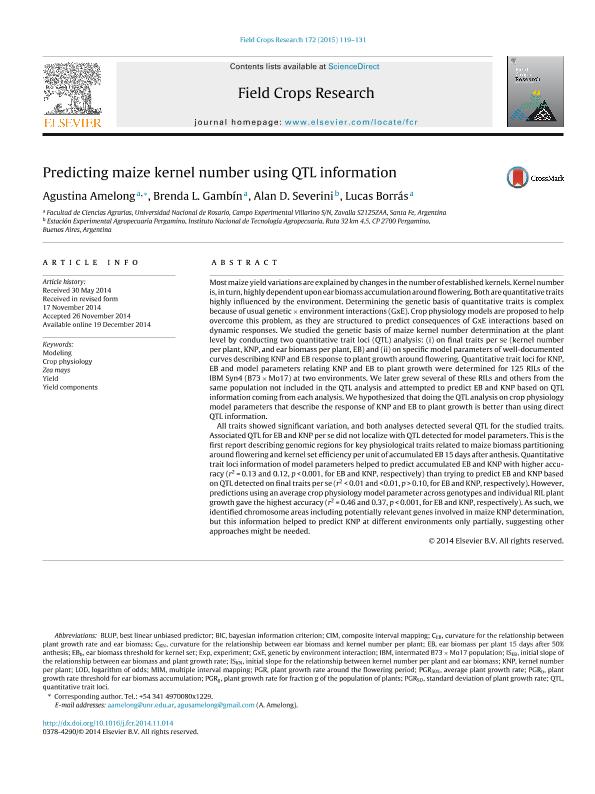Artículo
Predicting maize kernel number using QTL information
Fecha de publicación:
02/2015
Editorial:
Elsevier Science
Revista:
Field Crops Research
ISSN:
0378-4290
Idioma:
Inglés
Tipo de recurso:
Artículo publicado
Clasificación temática:
Resumen
Most maize yield variations are explained by changes in the number of established kernels. Kernel number is, in turn, highly dependent upon ear biomass accumulation around flowering. Both are quantitative traits highly influenced by the environment. Determining the genetic basis of quantitative traits is complex because of usual genetic. ×. environment interactions (GxE). Crop physiology models are proposed to help overcome this problem, as they are structured to predict consequences of GxE interactions based on dynamic responses. We studied the genetic basis of maize kernel number determination at the plant level by conducting two quantitative trait loci (QTL) analysis: (i) on final traits per se (kernel number per plant, KNP, and ear biomass per plant, EB) and (ii) on specific model parameters of well-documented curves describing KNP and EB response to plant growth around flowering. Quantitative trait loci for KNP, EB and model parameters relating KNP and EB to plant growth were determined for 125 RILs of the IBM Syn4 (B73. ×. Mo17) at two environments. We later grew several of these RILs and others from the same population not included in the QTL analysis and attempted to predict EB and KNP based on QTL information coming from each analysis. We hypothesized that doing the QTL analysis on crop physiology model parameters that describe the response of KNP and EB to plant growth is better than using direct QTL information.All traits showed significant variation, and both analyses detected several QTL for the studied traits. Associated QTL for EB and KNP per se did not localize with QTL detected for model parameters. This is the first report describing genomic regions for key physiological traits related to maize biomass partitioning around flowering and kernel set efficiency per unit of accumulated EB 15 days after anthesis. Quantitative trait loci information of model parameters helped to predict accumulated EB and KNP with higher accuracy (r2=0.13 and 0.12, p<0.001, for EB and KNP, respectively) than trying to predict EB and KNP based on QTL detected on final traits per se (r2<0.01 and <0.01, p>0.10, for EB and KNP, respectively). However, predictions using an average crop physiology model parameter across genotypes and individual RIL plant growth gave the highest accuracy (r2=0.46 and 0.37, p<0.001, for EB and KNP, respectively). As such, we identified chromosome areas including potentially relevant genes involved in maize KNP determination, but this information helped to predict KNP at different environments only partially, suggesting other approaches might be needed.
Palabras clave:
Crop Physiology
,
Modeling
,
Yield
,
Yield Components
,
Zea Mays
Archivos asociados
Licencia
Identificadores
Colecciones
Articulos(CCT - ROSARIO)
Articulos de CTRO.CIENTIFICO TECNOL.CONICET - ROSARIO
Articulos de CTRO.CIENTIFICO TECNOL.CONICET - ROSARIO
Citación
Amelong, Agustina; Gambin, Brenda Laura; Severini, Alan David; Borras, Lucas; Predicting maize kernel number using QTL information; Elsevier Science; Field Crops Research; 172; 2-2015; 119-131
Compartir
Altmétricas




